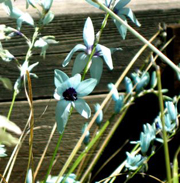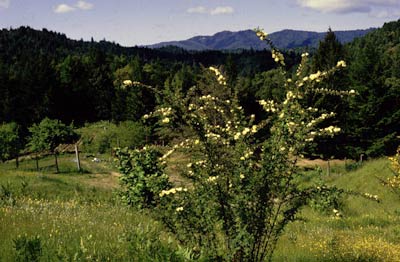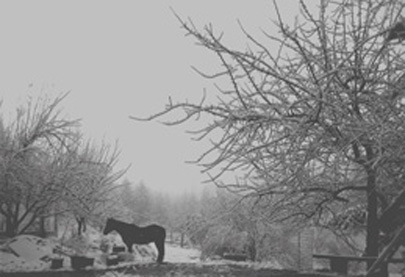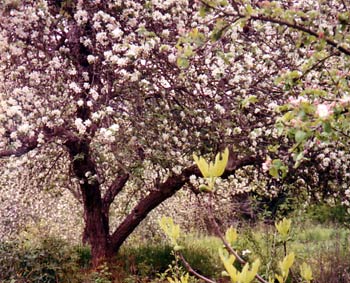Welcome to our home on the Web …..
Thirty-five years ago, we dedicated the Greenmantle Catalog - "To all the
Old-timers, Long may they thrive…." By now, most of the men and women
we were honoring have passed from the scene - leaving a legacy of
knowledge and cherished heirloom varieties. Our own generation is now
maturing into old-timers, and with this inheritance comes the
responsibility of stewardship.
Like the plants we
nurture - we're rather old-fashioned .......... Our apologies in advance
for not conforming to contemporary standards of electronic commerce.
Even as Greenmantle Nursery enters the Information Age, we remain
grounded in the down-to-earth work of preserving and sharing a living
horticultural heritage. All this takes time, but the two of us are
committed to traditional service - giving each order our personal
attention. |
|
Greenmantle does not maintain a regular
retail facility at our nursery grounds
and regretfully we
are unable to accommodate visitors.......

|
 |
|

Ixia viridiflora |
|
The Glastonbury Thorn........ Crataegus monogyna 'Biflora'
|
" Art does not yield the crown to Nature in the creation of a garden adorned with rare trees, and a green mantle always."
|
| Veronica Franco (1546 - 1591) |
Our Climate......and Organic Culture

"The
climate of Ettersburg is just like paradise, only you have
to work."
- Albert Etter (1872 - 1950)
Greenmantle Nursery is situated on 32 acres at an elevation
of 1500' in a remote area adjacent to the Kings Range National
Wilderness. Weather varies from extremely hot and dry in the summer,
to cool and very wet during the winter rainy season. Despite our
proximity to the Pacific Ocean, the Kings Range blocks the moderating
effect of marine air. While we see fog billowing in waves over
distant ridgelines, our own relative humidity remains quite low.
Consequently, our summer daytime temperatures frequently reach
into the 90's, then drop into the 40's at night. Highs of 115 degrees
F have been recorded and any rainfall between May and October must
be considered exceptional.
"To those of us who are gardeners and therefore
also interested in landscapes - the earth's green mantle
as it affords a home for man - these regions of winter rainfall
have a significance that immediately separates them in our
minds from other parts of the earth........ The traveler
always knows when he is in a Mediterranean land."
- Lester Hawkins (1915-1985), "A Gardener's
Guide to the Mediterranean Climate"
in The Pacific
Horticulture Book of Western Gardening 1990
The rainy season usually commences by November and continues
through April. During this period, we can receive 100" of
rainfall, and in some years upwards of 150" has been recorded.
Precipitation in these amounts makes us one of the wettest climates
in North America, with virtually all the moisture falling during
one-half of the year. While snow is an occasional phenomenon
and extended freezes have occurred, temperatures below 25 degrees
F are uncommon; our historic low was 9 degrees F in 1990. We
do get our share of light frost during the dormant season, hence
winter chill requirements have never been an issue for us in
the garden, orchards, or nursery.

Etter believed that the climate of the Ettersburg area was unusually felicitous
to a broad range of plant life, promoting vigor, size, and longevity - especially
for trees. Our region is notable for its venerable and giant specimens of Douglas
Fir, Coast Redwood, and Madrones. For domestic plantings, the lack of summer
rainfall mandates frequent deep irrigation. This offers a significant boon to
plant health; diseases like fireblight, apple scab, and rose black spot are much
less prevalent than they are in more humid places. This makes organic culture
a more viable option for gardener, orchardist, and nurseryman.
"Water,
soil, and the earth's green mantle of plants make up
the world that supports the animal life of the earth.
Although modern man seldom remembers the fact, he could
not exist without the plants that harness the sun's energy
and manufacture the basic foodstuffs he depends upon
for life....The earth's vegetation is part of a
web of life in which there are intimate and essential
relations between plants and the earth, between plants
and other plants, between plants and animals. Sometimes
we have no choice but to disturb the relationships, but
we should do so thoughtfully - with full awareness that
what we do may have consequences remote in time and place."
- Rachel Carson ( 1907-1964 ) Silent
Spring 1962
Since our inception, Greenmantle Nursery has adhered to a strictly organic approach
to plant cultivation. We use no chemical fertilizers, pesticides, fungicides,
or herbicides. To counteract the constant leaching of nutrients caused by our
heavy winter rains, we are always working to build up the soil's organic matter.
Composted horse manure is our main reliance, occasionally supplemented with natural
amendments like fish and kelp meal. Bins of redworms digest kitchen waste and produce a first-rate soil dressing. Plants do respond to timely attention, especially where it
comes to water and nutrients. Pests and predator animals always impose
a challenge that requires constant vigilance.
In the
end, the old Chinese proverb rings true: The best fertilizer
is the footsteps of the farmer.
"Put your ego
in your compost heap"
The Greenmantle Catalog © 1983

Our Duchess
of Oldenberg Apple Tree (1895-2003) "Human beings, vegetables, or cosmic
dust - we all dance to
the mysterious
tune intoned in the distance by an invisible piper ."
- Albert Einstein (1879 -1955) All Original Text and
Images © Greenmantle Nursery 2005 -2021 |